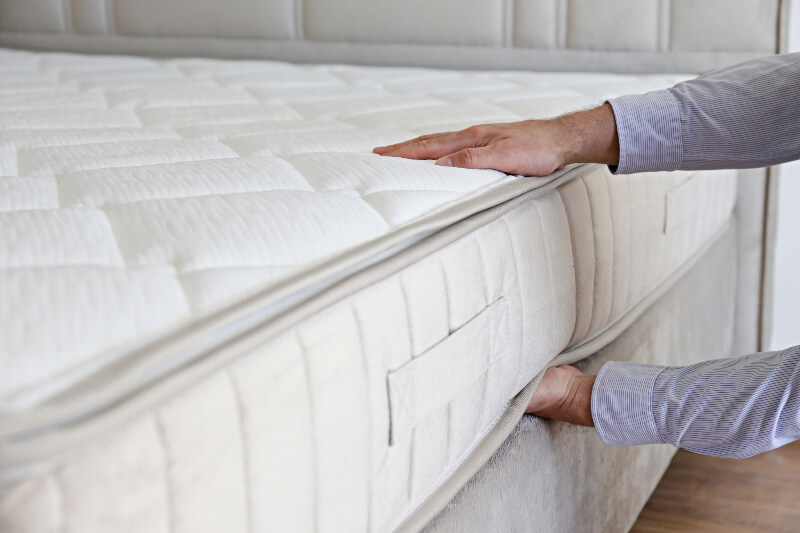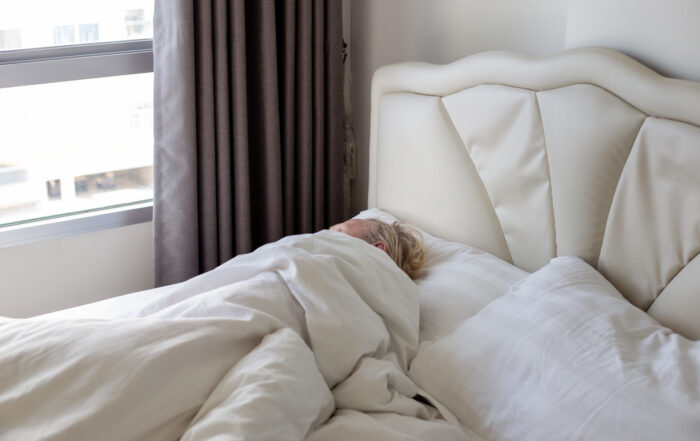What is Mattress Ticking, and Why is it Important?
Social Links
There’s nothing like a good mattress and that feeling of sinking down into its soft surface at the end of a long day. It’s a wonderful feeling to wake up feeling warm and cocooned, knowing we’ve had a good sleep.
Equally, we all know when we’ve slept on a bad mattress because we wake up feeling as though we haven’t slept at all. In fact, the reason we say “it’s good to be home” after a holiday is probably because we’re looking forward to sleeping in our own bed again.
When you bought your mattress, you probably chose one based on how it felt and what it’s made of – springs, memory foam or latex. But did you know that the outer covering of a mattress can have just as much to do with its comfort and support as the construction of the mattress itself? This outer covering is called mattress ticking, and it’s a good indicator of the quality of the mattress. So if you’re in the market for a new mattress, it’s worth delving further into mattress ticking so you know what to look out for.
What’s in a mattress?
Most mattresses contain two layers – a support layer and a comfort layer. The support layer goes at the bottom and usually contains coils, foam, or a combination of both. Its purpose is to support the body’s alignment while you sleep and keep you from sinking too far into the mattress. The comfort layer acts as a cushion between the body and the support layer and may contain foam or other fibres. While it contributes to the firmness of the mattress, it should feel comfortable and soft and cushion your body’s pressure points.
Around these two layers goes a non-removable outer covering, encasing any edges or stray fibres – The mattress ticking What is mattress ticking?
Mattress ticking is the final, outer layer of the mattress – it’s the non-removable covering over the support and comfort layers but separate from any toppers or protectors. The word comes from the Greek word theka, which means a case or covering, and traditionally refers to a tightly woven, sturdy textile like cotton or linen encasing the inner materials of the mattress. In the past this was often straw or feathers, so the fabric ticking had to be strong enough to prevent quills or bits of straw from poking through it. This tight weave was sometimes strengthened by wax, soap or starch.
Nowadays mattress interiors are a bit less prickly, but they still need to be protected by a strong outer layer. Fabric for mattress covers now includes wool and polyester, and depending on the internal construction of the mattress it may have reinforced sides (to prevent sagging), or a non-slip base (if it’s a no-flip mattress). All these factors combined have a significant impact on the overall comfort, flexibility, temperature, and airflow of the mattress.
Types of mattress ticking
Because of the variety of materials and manufacturing methods available, the fabric for mattress covers can be almost anything – but most of the commercially available types can be narrowed down into four categories:
Damask
Damask is a soft and breathable fabric, woven so that any patterns – traditionally a stripe in muted colours – can be seen on both sides. It can be made of natural or synthetic fibres, and the tight weave makes it highly durable. Damask is usually found on sprung mattresses and is the cover of choice for The Mobility Furniture Company’s Leda range. It’s also very flexible, and can therefore be used on mattresses for adjustable beds.
Knitted
Memory foam or latex mattresses are usually covered with a knitted fabric, which is slightly softer and flatter than a damask. They’re not as breathable but they’re very soft and stretchy, which makes them a better match for the flexibility and elasticity of foam. To enhance breathability, some knitted covers may incorporate Coolmax technology, such as in The Mobility Furniture Company’s memory foam range, or for comfort they may be infused with gel, such as in The Mobility Furniture Company’s Eros and Solaris models.
Stitchbond
Stitchbond is the lowest quality of mattress cover available, and therefore the cheapest. Patterns are printed rather than woven and they’re generally not very flexible or breathable, though depending on the fabric they may have some durability. Stitchbond fabric ticking is usually found on low-quality, non-supportive mattresses, such as what may be used a camp bed or low-end sofa bed. It might be ok to sleep on for a night or two, but if you’re investing in a good quality, individually sprung or foam mattress then you’re better off with a damask or knitted cover.
Specials
Anything that’s not damask, knitted or stitchbond can be classified as a special covering. This may be a special blended fabric, such as polyester woven with another material, a waterproof cloth or perhaps a fabric infused with anti-bacterial or hypo-allergenic properties. These tend to come and go with market trends and may suit some individual needs, but in most cases, good quality damask or knitted fabric ticking will be all that you need.
What else to look for in a mattress cover
Side stitching
Side stitching refers to how the side panels on the mattress are finished. Foam mattresses don’t need it, but without it coil mattresses will lack support at the edges and may sag. To determine quality, look for at least two rows of stitching, which should be hand rather than machine stitched and shouldn’t bulge out when you press down on them.
Surface finishing
Look for hand tufting or a quilted finish on the mattress. Tufting refers to the buttons, pom poms or tufts that appear on the top of the mattress and help keep the internal upholstery stable. Quilting is more common, and is the process of stitching the outer fabric mattress cover to the layer of material directly underneath it to create a padded effect. This can be done in any number of patterns and combinations, and explains why similar mattresses may have different names.
The bottom line
No matter how good your mattress is, it will need to be replaced eventually – hopefully with one that’s just as good, or even better. When the time comes, you probably know to do your research about the type and level of support that’s right for you, as your needs – and mattress technology – will probably have changed since the last time you bought one.
Part of the process is choosing the right sort of cover, or “ticking”. You want it to be soft and comfortable, but also flexible and durable. You also want to make sure it offers good support so you avoid aches, pains and your body feels supported while you sleep.
If in doubt, talk to an Mobility Furniture Company consultant who can arrange for some of our mattresses to be brought to your home for you to try out. All of our options come with high-quality ticking designed to complement the interior construction, so rest assured, we’ve got you covered!
*This website contains general medical information. The medical information is not advice and should not be treated as such. Read our full Medical Disclaimer here.



